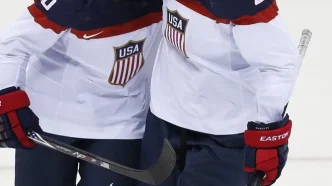Tessa Janecke tossed her stick into the crowd, a jubilant celebration of her game-winning goal that clinched the 2025 IIHF Women’s World Championship for Team USA against Team Canada. After more than 17 minutes of nail-biting overtime, the 20-year-old Penn State forward’s contribution sealed a thrilling 4-3 victory and secured her second gold medal in just three years since joining the senior national team in 2023.
Janecke’s elation was palpable as she donned her gold medal, admitting, “I kind of blacked out.” The moment was a mirror of the excitement felt by fans, echoing the kind of spontaneous joy that makes sports so captivating.
Her goal, the “golden goal” if you will, exemplified her budding reputation as one of the sport’s top young talents. The play began with Canada’s puzzling line change, which should have raised eyebrows. It was Janecke’s aggressive forechecking on veteran Jocelyne Larocque that disrupted Canada’s game plan, allowing Taylor Heise to pounce on a loose puck, capitalizing on the defensive lapse. Janecke then made a heads-up play, positioning herself backdoor to redirect a well-placed shot-pass from Heise past Ann-Renée Desbiens, pushing into the netminder’s space and finishing what she started.
“I strive to be the best 200-foot player that I can be,” Janecke said, illustrating her commitment to both ends of the ice. “Just going in there hard, trying to turn any puck over, is all I’m trying to do. And I just happened to be in the right spot at the right time.”
Coming off a heartbreak last year where the U.S. fell to Canada in the gold medal final on home ice, this victory brought a much-needed sense of redemption for Team USA. The Budvar Arena was filled to the brim, capturing the intensity of the cross-border rivalry that has become a hallmark of women’s hockey.
After a scoreless first period, the action exploded in the second with four goals in less than three minutes. Caroline Harvey kicked things off for the U.S. with a keen shot during a frenzy in front of the net. Just 30 seconds later, Abbey Murphy found the back of the net, pushing the Americans up 2-0. It felt like momentum was firmly in Team USA’s favor. But with Canada’s resilient style of play, this wouldn’t last.
“We were thinking, after we scored our second goal, ‘Let’s get another one, let’s keep rolling,’” Janecke recalled, revealing the confidence that surged through the U.S. bench at that moment. Just as quickly, that optimism dwindled when Danielle Serdachny struck back for Canada, cutting the lead in half, and Jennifer Gardiner tied the game less than a minute later.
The rapid-fire scoring displayed the high-stakes intensity that has come to define these encounters. By the end of the second period, the teams returned to the locker rooms deadlocked at 2-2, a testament to the unpredictable ebb and flow of the game.
Head coach John Wroblewski knew this roller coaster was all too familiar. “Every time we’re in one of these games, it never goes according to the plan,” he said. “It’s a roller coaster every single time. I don’t like roller coasters, but I like these games.”
A pivotal moment arose early in the third period as U.S. goalie Aerin Frankel went down after colliding with Canadian forward Laura Stacey during a scramble for the puck. As a hush fell over the arena, Frankel remained on the ice for several moments before being helped off.
“I didn’t like the hit,” said U.S. captain Hilary Knight. “Aerin does so much for us. I hope she’s OK.”
Enter Gwyneth Philips, a rookie with only two games of women’s worlds experience under her belt. While concern for her teammate weighed on her, Phillip’s focus quickly shifted to her role as a backup—ready to seize an opportunity. “There was very limited calmness, I would say,” she reflected about entering the high-stakes game in such an unpredictable scenario.
Recognizing the moment, Philips stepped up: on a five-on-three power play following penalties to Stacey and Sarah Nurse, Heise wasted no time, scoring to give the U.S. their third goal.
Wroblewski called a timeout after the go-ahead goal, a moment that turned into a significant part of game strategy as Philips took to the ice. “Aerin leaned over to give me a hug,” Philips remembered, adding, “I was like, ‘Listen, you were making the play, but we’re going to win this thing.’”
With just five minutes remaining, Sarah Fillier tied the game again at 3-3, setting the stage for yet another overtime thriller between these two rivals. Philips stood tall under pressure, making 17 saves on 18 shots, including 10 in the overtime period alone.
As the final minutes of overtime ticked down, it was Janecke who emerged as the hero, netting the goal that not only crowned Team USA champions but also showcased her potential as a future star in women’s hockey. “Gwyn kept us in the game,” Knight noted after the victory, extending her record for the most gold medals at women’s worlds to an impressive 10.
In a game filled with narrow margins, Canada threw everything they had at the American netminders, racking up 47 shots on goal. Coach Troy Ryan lamented after the loss, “The margins for error are small. Either team could have won it; it’s just a matter of finishing opportunities.”
As Canadian captain Marie-Philip Poulin reflected on the loss, she acknowledged the bittersweet sting given the looming 2026 Olympics. “I think it’s going to be motivation for all of us in the next couple of months,” she stated thoughtfully, knowing the competitive spirit that will drive both her team and herself moving forward.
With Poulin leading the tournament in scoring and being named MVP, the anticipation builds as the U.S. heads to Milan, not only riding the wave of their gold medal victory but perhaps also stepping into favorites territory as the horizon for the upcoming Olympics draws near.








